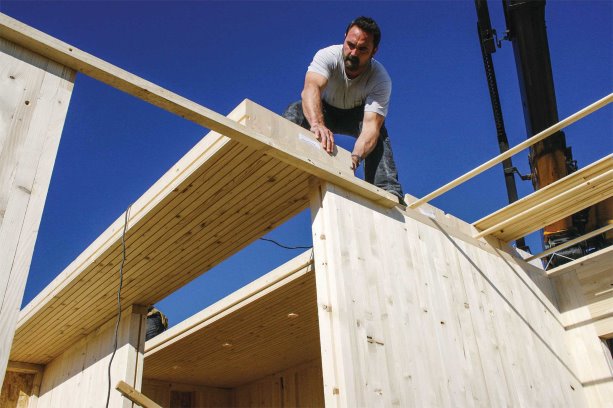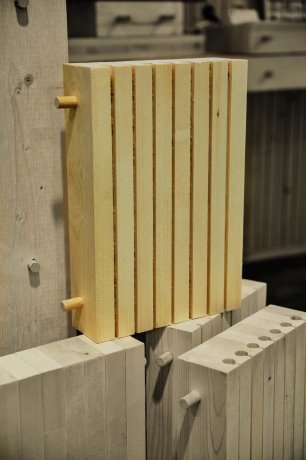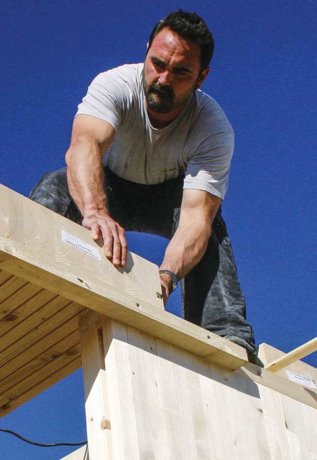StructureCraft Builders Corporation is building a 50,000-square-foot, all-wood facility in Abbotsford, B.C. to manufacture dowel laminated timber (DLT). DLT is made entirely from softwood and hardwood with no metal, glue or plastic.
"We expect the plant to be completed by the end of summer 2017 and the first DLT to be available for sale in January 2018," said Lucas Epp, StructureCraft’s head of engineering.
He said his company will be the first manufacturer of DLT in North America.
DLT panels have all the wood fibre going in a single direction and use dowelling patterns instead of nails or layers of glue.
The panels can be used for floor, wall and roof structures.
Epp said DLT is less expensive than glued products to manufacture. The bright idea to use hardwood dowels to connect softwood boards was conceived in Switzerland in the 1990s.
Today there are about 20 DLT manufacturers in Europe, most of them in Germany, Austria and Switzerland.
DLT may be the most recent mass timber product, but it joins many others already on the market.
Some of them are nail laminated timber (NLT), cross laminated timber (CLT), glue laminated timber (GLT), laminated veneer lumber and laminated strand lumber.
"Architects and structural engineers are becoming more familiar with the properties of structural engineered wood," said Jana Foit, senior associate at Perkins+Will Architecture in Vancouver.
Engineered wood has advantages over steel and concrete as a structural material, said Foit.
"For example, it is faster to erect," she said. "On the other hand, engineered wood is vulnerable to wet weather and construction needs to be scheduled to mitigate the effects of moisture."
Although mass timber has been used in Europe for decades, Canada is catching up quickly, said Duane Palibroda, managing principal of Vancouver structural engineers Fast + Epp.
"We have been working with mass timber on projects in the Lower Mainland for several years," Palibroda said.
Examples of Fast + Epp projects that use engineered wood include the Brentwood Skytrain Station in Burnaby; Brighouse Elementary School in Richmond; the Mountain Equipment Co-op head office in Vancouver; and the Whistler Public Library.
In addition to Fast + Epp, and thanks in part to the B.C. government’s Wood First Initiative, other companies in the construction industry are finding structural applications for engineered wood, said Mark Porter of Associated Engineering in Burnaby.
"Engineered wood is more stable than regular sawed lumber, stronger and more predictable in its behaviour," he said. "One of the most recent engineered wood products to be used in Western Canada is CLT."
Much ink has been spilled recently on the use of CLT in the 18-storey Brock Commons student residence at the University of BC.
"Brock Commons is the first mass timber tower in North America," said Karla Fraser, senior project manager at Urban One Builders CM Inc., the project’s construction manager. "And it is the first time we have used CLT as a structural floor plate as part of a wood tower. But it will not be the last time we use this type of building material."
Fraser said CLT is an easier building material to manage throughout the construction of a project.
"Due to its cross lamination it is not susceptible to curling when it gets wet," Fraser said. "It is unlike NLT or GLT, which tends to curl the entire member when exposed to rain."
Moisture on CLT, on the other hand, could be managed with fans and by removing the water from the surface of the wood.
"Within a few hours of moving the water off the wood, it came back to kiln-dry moisture readings," Fraser said.
Projects such as Brock Commons are also noteworthy because the use of engineered wood has been leading to increased co-operation between structural engineers and building science engineers.
"Engineered wood buildings are built quickly and some special weather protection is required during construction," said Leslie Peer, principal of engineers Read Jones Christoffersen Ltd. "This aspect of engineered wood construction is driven by computer-aided pre-manufacturing of building elements, which is a big change in the construction industry and is moving ahead rapidly in the wood sector."
Building elements are manufactured precisely off-site and erected by small crews on site.
"Since wood is affected onsite by moisture absorption more than steel or concrete is, it needs to be protected during construction," said Peer. "That is behind the need for temporary protection and more rapid installation of the building facade and roof."

1/2
StructureCraft Builders Corporation is building a 50,000-square-foot, all-wood facility in Abbotsford, B.C. to manufacture dowel laminated timber (DLT), the first of its kind in North America, says Lucas Epp of StructureCraft. The panels can be used for floor, wall and roof structures.
Photo: StructureCraft
2/2
Dowel laminated timber (DLT) is made entirely from softwood and hardwood with no metal











Recent Comments
comments for this post are closed